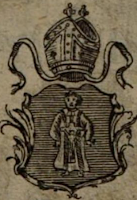Sunday, 18 February 2024
Waterford Palace
The bishopric of Lismore had been founded in the beginning of the 7th century; but that of Waterford was not founded until about the close of the 11th century by the Ostmen of Waterford, soon after their conversion to Christianity.
During the prelacy of Thomas le Reve, who succeeded in 1363, the sees of Lismore and Waterford were consolidated by Pope URBAN V, and this union, which had been long contemplated and frequently attempted without success, was confirmed by EDWARD III.
Hugh Gore, who was consecrated Bishop of the united sees in 1666, expended large sums in repairing and beautifying the cathedral, and bequeathed £300 for bells for the churches of Lismore and Clonmel, and £1,200 for the erection and endowment of an almshouse for ten clergymen's widows, to each of whom he assigned £10 per annum.
Nathaniel Foy, who was appointed Bishop in 1691, greatly improved the episcopal palace, and bequeathed funds for the erection and endowment of a school for 50 children, afterwards extended to 75, and for the improvement of the estates, the surplus funds to be applied to clothing and apprenticing the scholars.
The two sees continued to be held together till the decease of Bishop Bourke, when both were annexed to the archiepiscopal province of Cashel, and the temporalities became vested in the Ecclesiastical Commissioners.
This very small diocese is confined to the eastern part of County Waterford, and does not extend above 13 miles in length and 9 in breadth.
But the diocese of Lismore is 38 miles long and about 37 broad, including the greatest part of County Waterford and a considerable portion of Tipperary.
THE PALACE, WATERFORD, County Waterford, is reputedly one of the largest and finest episcopal residences in Ireland.
Building began in 1741 by Bishop Este, to the design of Richard Castle.
The garden front, facing the Mall, comprises three storeys.
The rusticated ground floor serves as a basement.
Its centre breaks forward with three arches which form the base of the pedimented Doric centrepiece above, which incorporates three windows.
The centre of the top storey features a circular niche between two windows.
Bishop Este died in 1745, before the palace was completed.
It ceased to function as an episcopal residence in 1919, following the retirement of Bishop O'Hara.
Thereafter it was occupied by the Bishop Foy boarding school until 1967.
It served as municipal offices for Waterford City Council till 2010.
The former episcopal palace is now a museum.
First published in November, 2015.
Labels:
Episcopal Palaces
Subscribe to:
Post Comments
(
Atom
)







No comments :
Post a Comment